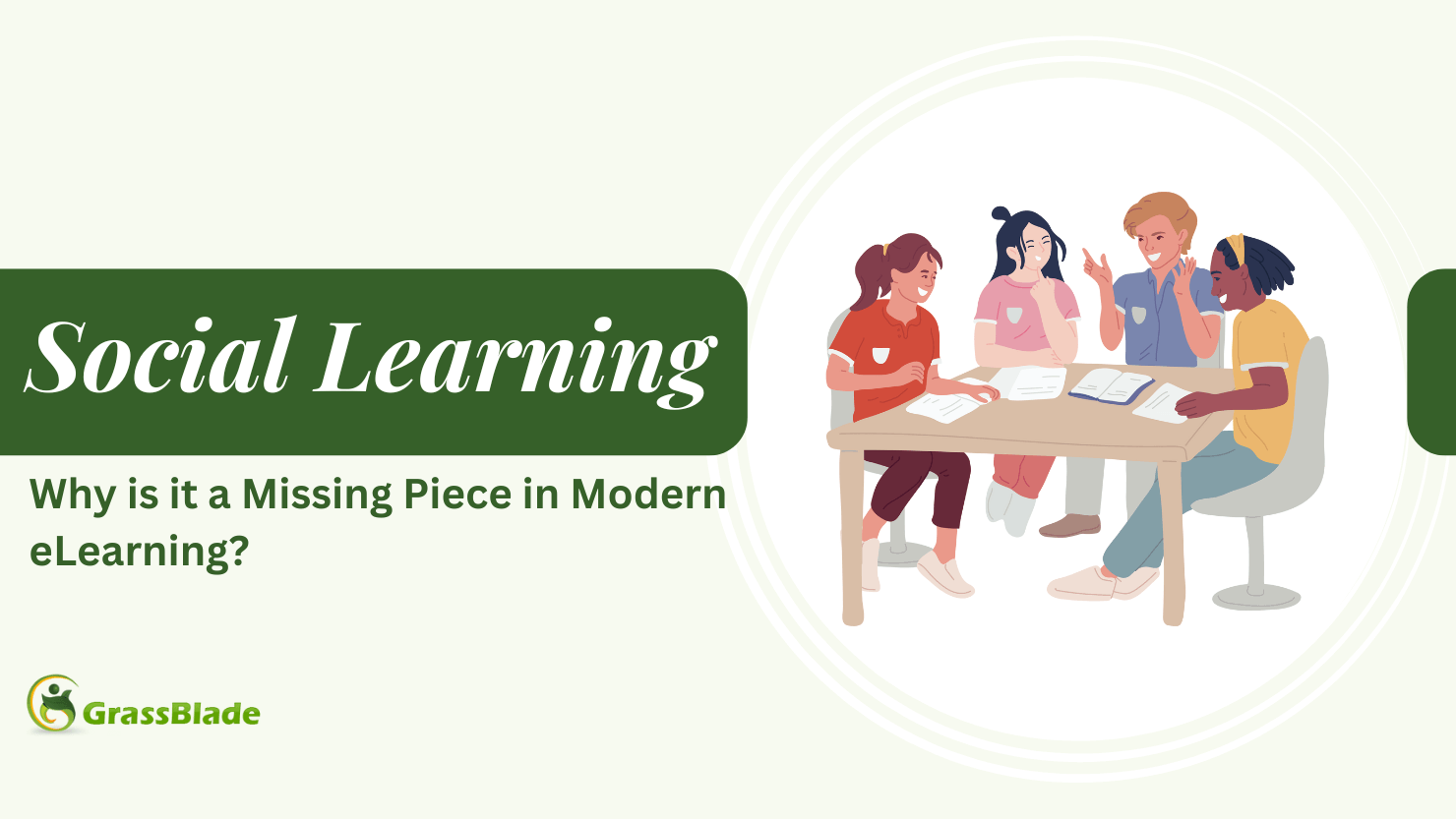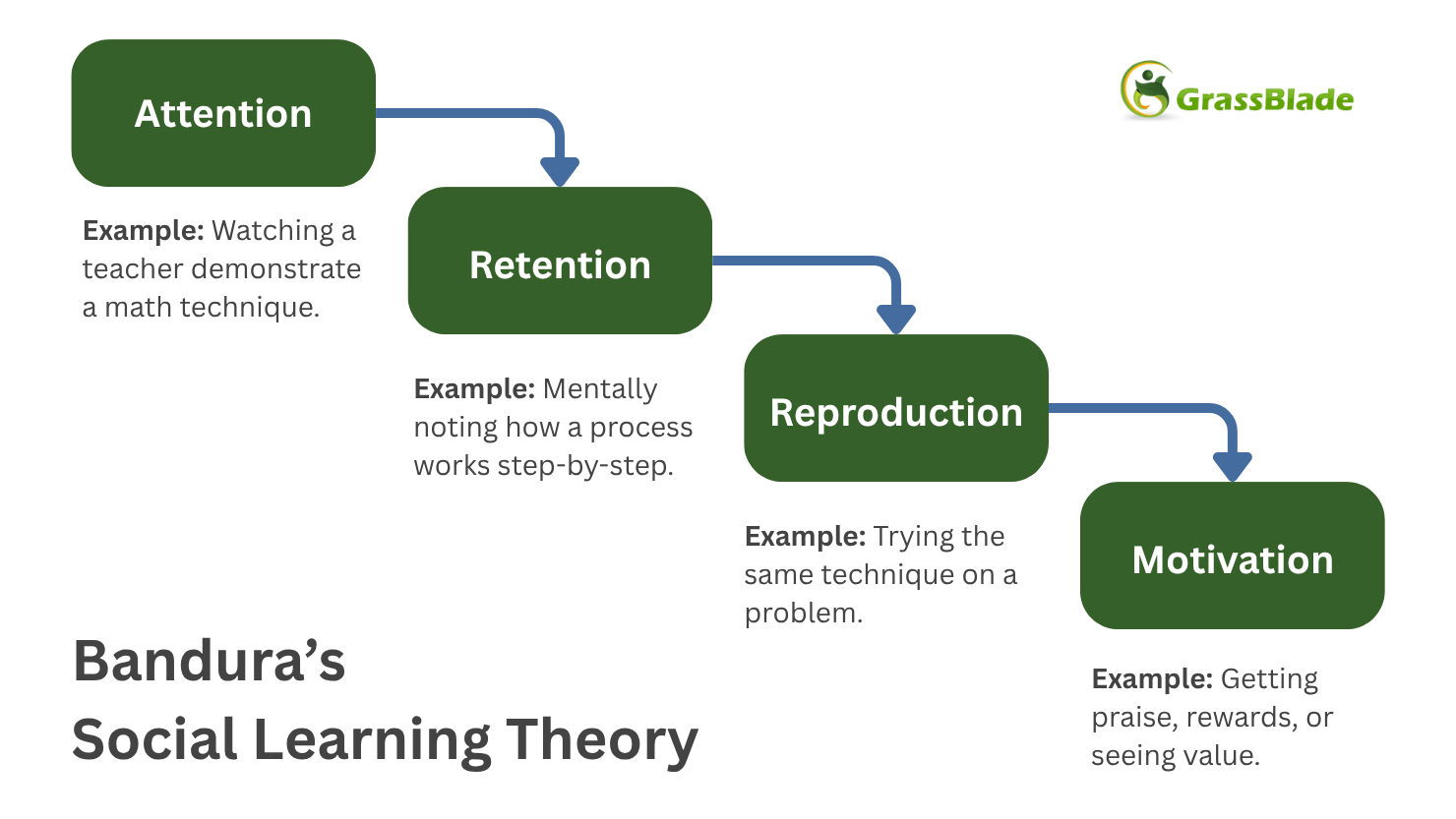
eLearning fixed a lot of issues in education and training, such as interactivity, engagement, immersive training, and the inclusion of technologies such as AR and VR to simulate real-world scenarios for training and learning without risk. But it has caused some problems; learners are now stuck at their screens, consuming only learning content, lacking collaboration, connection, and engagement with other learners.
Learning doesn’t happen in isolation; it thrives when learners interact with other learners and discuss or debate the topic. This is where social learning steps in. Social learning can be integrated into modern eLearning techniques.
What is Social Learning in eLearning: A Deep Dive
Social learning is a process of acquiring knowledge through interaction, collaboration, and observation of other learners. In eLearning, it involves tools such as forums, chats, and social media-like features within an eLearning platform.
Understanding Bandura’s Social Learning Theory
Social learning involves acquiring knowledge through observation, collaboration, and interaction with others. This process is known as observational learning, and it highlights the power of peer influence and shared experiences.

How Social Learning Happens in an eLearning Environment
Let’s consider that learners are taking a programming course. They use forums to share issues and solutions, while comments help highlight or clarify code snippets. Chat tools such as Discord or Slack support collaboration and peer interaction. Team projects, like building a small app, simulate real-world teamwork. These activities make learning engaging and boost learning retention.
How Formal vs Informal Learning Works in eLearning
Formal learning is characterized by structured lessons, quizzes, and assessments, whereas social learning thrives in an informal learning environment. Activities such as peer discussion and feedback, as well as spontaneous problem-solving group chats, create a more collaborative environment that mirrors real-world learning.
Why Traditional eLearning Often Falls Short
Traditional eLearning often lacks the interactive, human-centered elements that drive real engagement and understanding. It typically relies on static, content-heavy formats like long videos or text-based lessons. This results in a one-way information flow, where learners passively consume content without any opportunity for discussion, reflection, or collaboration.
Over time, this passive approach fails to sustain learner interest or motivation, especially in environments where social connection and shared learning experiences are absent.
How Social Learning Transforms eLearning
Social learning transforms isolated, passive learners who simply consume static content, into active participants. When learners are encouraged to discuss, collaborate, and contribute, they begin to take ownership of their learning. They are now not just consuming the content but interpreting it, reacting to it, and applying it through interaction. This builds a strong learning community, and peer feedback, real-time knowledge exchange, boosts learner confidence and knowledge retention.
Real-World Applications of Social Learning in eLearning
Social learning in LMSs
Some modern LMSs, like Moodle, LearnDash, and Lifter LMS, include comment threads or offers discussion forum. These tools allow learners to ask questions, share insights, and support one another.
Corporate eLearning
Companies have now increasingly started to integrate social learning into their training programs using communication tools such as Slack, Microsoft Teams, or even Discord. These channels allow employees to engage in informal discussions around content, ask questions, and share practical applications of what they have learned.
Higher Education Platforms with Peer Review Study Groups
Universities and other online higher education platforms use peer-reviewed assignments and collaborative group projects to enhance student engagement. Tools such as Blackboard, Canvas, and Google Classroom are leveraged to support social learning through peer assessment, shared workspace, and group chats.
MOOCs and Open Learning Environments
Platforms like Coursera, edX, and FutureLearn utilize discussion forums to support social learning. This allows thousands of learners to exchange thoughts, help each other solve problems.
Tools That Enable Social Learning in eLearning
LMS & Plugin-Based Tools
- Discussion Boards: For WordPress LMS, you can use the BuddyPress or BuddyBoss plugin to set up a discussion forum in your LMS. Moodle LMS provides a discussion forum out of the box.
- Peer Review Assignment: For this feature, there isn’t a direct solution in WordPress, but there is a workaround. You can use Gravity Forms with Gravity View to simulate a peer review assignment. You can create an assignment form and then display it with Gravity View. You can then use another form for peer feedback on the assignment. Moodle LMS provides peer review assignments out of the box.
- Comments & Group-based permissions: Most modern LMSs, including Moodle, offer these features out of the box.
Gamification Tools
GamiPress/BadgeOS: These WordPress plugins allow you to award points, badges, and achievements for socially engaging behaviors, like posting in a discussion, replying to a peer, or completing a group challenge.
Advanced Tracking
- Learning Record Store (LRS): A tool like GrassBlade LRS helps you to store and analyze tracking data. This is a very powerful tool to know how learners are performing or interacting in group-based learning, what their achievements are, etc.
- GrassBlade xAPI Companion: It is a WordPress plugin that allows you to track learner interaction and send every granular interaction data to the LRS.
Other Tools
- Communication Platforms: Tools such as Microsoft Teams, Slack, and Discord support real-time discussions, group chats, and collaborative problem solving.
- Google Classroom & Miro: Google Classroom is a classroom-like digital tool that allows classroom-like collaboration and group activity management. Miro, on the other hand, enables real-time whiteboarding and brainstorming.
Best Practices to Incorporate Social Learning into eLearning
Design for interaction
Create your eLearning content, keeping social interaction in mind. Social learning doesn’t happen by accident; it must be intentionally designed. Embed tools such as discussion forums, peer review assignments, and collaborative challenges strategically into the course structure.

Blend Synchronous and Asynchronous Elements
Combine real-time interactions, such as Zoom sessions, a virtual classroom, or a live webinar, with self-paced activities such as collaborative tasks. This blend ensures flexibility while still fostering consistent social exchange.
Moderate with Intent
To ensure that social learning works well, someone will have to guide the discussions in the forum. If no one leads, people might stop talking or go off topic. And this is where a moderator comes in: a moderator encourages everyone to join the conversation, asks helpful follow-up questions, and highlights good or thoughtful answers. Assign a dedicated moderator to guide discussions, ask clarifying questions, and ensure meaningful participation.
Use Analytics to Identify and Nurture Engagement
Tools like LRS and GrassBlade xAPI Companion allow you to track learner engagement beyond lessons and quiz completion. Track and analyze learners’ participation in peer activities, social interactions. Use these data to personalize learning content.
Recognize and Reward Participation
Use gamification elements such as points, badges, and leaderboards along with social learning.
Reward learners for activities such as contributing to forums or reviewing peer submissions. Integrate the leaderboard to create competitiveness.
Conclusion
Social learning brings a human element to eLearning. It fills a critical gap in eLearning by turning the isolated learning process into a shared experience. With tools like a discussion forum, you create a community-based learning environment. And it increases motivation, participation, and retention of knowledge.
Social learning is a must if you want the most out of your learning content. Use tools like discussion forums and gamification plugins, track and analyze with GrassBlade xAPI Companion and LRS, and improve your learning material.
